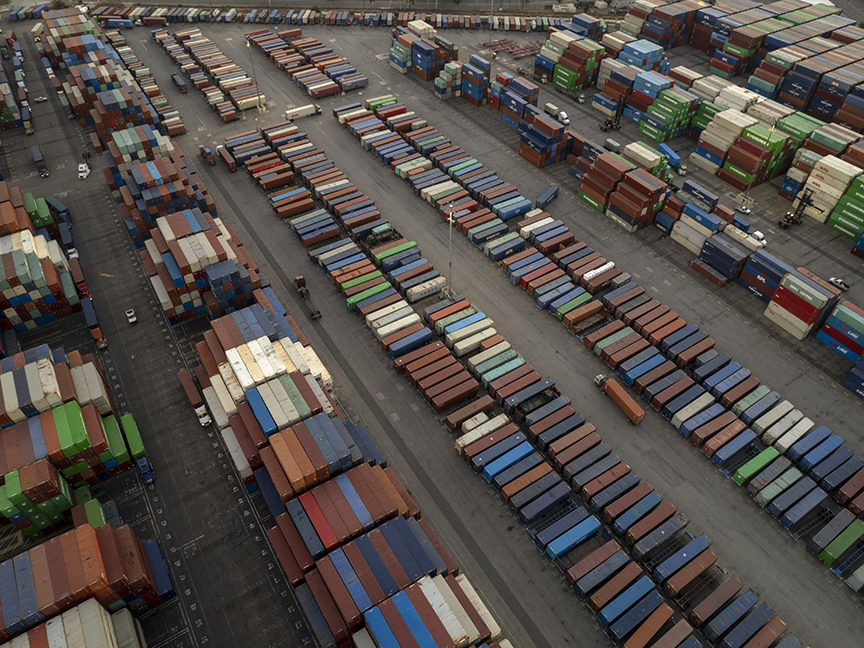
Visit Our Sponsors |
|
|
|
|
|
|
|
|
|
|
|
|
|
|
|
|
|
|
|
|
|
|
|
|
|
|
|
|
|
|
|
|
|
|
|
|
|
|
|
|
|
|
|
|
|
|
|

The Port of Los Angeles, the busiest in the U.S., has enlisted the help of the White House to clear a backlog of rail-bound containers that’s tripled since February, taking up space on its docks and causing congestion as the operation prepares for an early peak season.
There are more than 29,000 rail-container units on the ground, half of which have been waiting to be picked up for nine days or more, Port of Los Angeles Executive Director Gene Seroka told reporters in a virtual briefing Tuesday. In January, the dwell time was about two days on average.
The port of L.A. is going “all out to catch up on this real cargo,” which has increased sixfold since February, Seroka said. “We’re working around the clock with White House senior officials in Washington and Sacramento local authorities as well as both private-sector railroads, the Union Pacific and the Burlington Northern Santa Fe,” he said, referring to BNSF Ltd.
Retailers and manufacturers watch the ports of L.A. and neighboring Long Beach, the gateway for about 40% of containerized trade with Asia, for any signs of a repeat of disruptions that rippled through global supply chains at the height of the pandemic, causing shortages, delays and higher prices.
Read more: U.S. Ports Brace for Early Cargo Peak as Consumers Keep Buying
The port complex has dealt with sustained high volumes since the onset of the pandemic, with its three busiest months all taking place since October 2020. U.S. supply chains have strained under unprecedented demand, worker and truck-chassis shortages and a shift to buying more material goods as Americans avoided travel.
Both ports foresee cargo arrivals for 2022 peaking this month compared with a spike that came in later months in prior years. In L.A.’s case, it’s because of retailers stocking up on back-to-school and fast-fashion products, while Port of Long Beach Executive Director Mario Cordero has said the loosening of COVID-19 restrictions in China may result in an extra wave of products arriving at his operation.
Stripping out rail, the port of L.A. has “no problem with aging containers, and we’re moving imports fluidly through this port complex,” Seroka said. “We’ve got to continue to pump this cargo out.”
The port chief said inland rail terminals in places like Chicago, Memphis and Dallas need to get product to importers and beneficial cargo owners more speedily, who in turn would move it to storefronts and fulfillment centers “much quicker than we’re doing right now.” Stephen Lyons, who President Joe Biden appointed as the White House supply chain envoy replacing John Porcari in May, is working with BCOs to speed up the process, Seroka said.
Delays on picking up containers and chassis around the port are growing, the port chief said, with the so-called street dwell sitting at nine days compared with a usual 3.5 days.
Digital System
Having a digital freight-portal system that tracks all containers and rail cars in the system in real time would help to ease bottlenecks, according to Michael Dykes, the president of the International Dairy Foods Association, whose members produce about 90% of the dairy products sold in the U.S.
Speaking on the L.A. port’s call, he said the U.S. needs more inland areas where chassis and containers can be stored closer to the source of export products.
“We need greater connectivity in all modes of transportation. We need greater space for rail at these ports, so that we can use the rail to get some of these agricultural products from the interior to the port,” he said.
RELATED CONTENT
RELATED VIDEOS
Timely, incisive articles delivered directly to your inbox.






